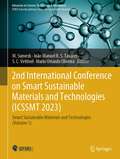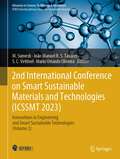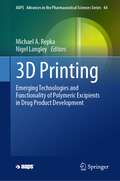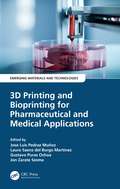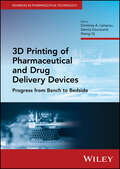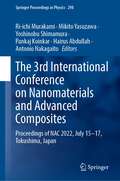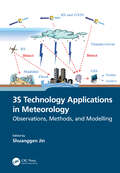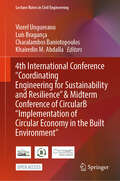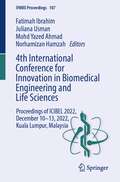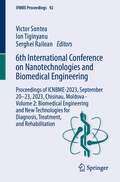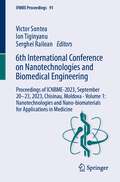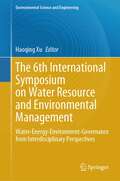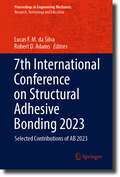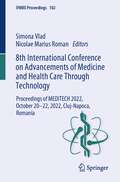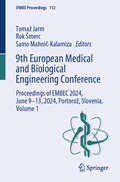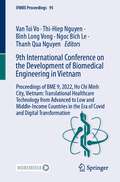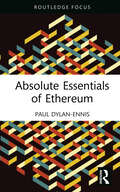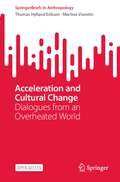- Table View
- List View
2nd International Conference on Smart Sustainable Materials and Technologies: Smart Sustainable Materials and Technologies (Volume 1) (Advances in Science, Technology & Innovation)
by M. Sumesh João Manuel R. S. Tavares S. C. Vettivel Mario Orlando OliveiraSustainable materials science and engineering is one of the important characteristics of the existing high-tech revolution. The advances of materials science pave way for technical advancements in materials science and industrial technologies throughout the world. Materials are regarded as critical component in all emerging industries. Exquisite preparation and manufacturing must be carried out before a new material may be used. Nevertheless, electronic materials are undeniably important in many aspects of life. Smart materials and structures is a multi-disciplinary platform dedicated to technical advances in smart materials, systems and structures, including intelligent materials, sensing and actuation, adaptive structures, and active control. Recently, sustainable materials and technologies reshape the electronics industry to build realistic applications. At present, without the impact of sustainability, the electronics industry faces challenges. Researchers are now more focused on understanding the fundamental science of nano, micro, and macro-scale aspects of materials and technologies for sustainable development with a special attention toward reducing the knowledge gap between materials and system designs. The main aim of this international conference is to address the new trends on smart sustainable materials field for industrial and electronics applications. The main purpose of this conference is to assess the recent development in the applied science involving research activity from micro- to macro-scale aspects of materials and technologies for sustainable applications. In such a context, particular emphasis is given to research papers tailored in order to improve electronic and industrial applications and market extension of sustainable materials.
2nd International Conference on Smart Sustainable Materials and Technologies: Innovations in Engineering and Smart Sustainable Technologies (Volume 2) (Advances in Science, Technology & Innovation)
by M. Sumesh João Manuel R. S. Tavares S. C. Vettivel Mario Orlando OliveiraSustainable materials science and engineering is one of the important characteristics of the existing high-tech revolution. The advances of materials science pave way for technical advancements in materials science and industrial technologies throughout the world. Materials are regarded as critical component in all emerging industries. Exquisite preparation and manufacturing must be carried out before a new material may be used. Nevertheless, electronic materials are undeniably important in many aspects of life. Smart materials and structures is a multi-disciplinary platform dedicated to technical advances in smart materials, systems and structures, including intelligent materials, sensing and actuation, adaptive structures, and active control. Recently, sustainable materials and technologies reshape the electronics industry to build realistic applications. At present, without the impact of sustainability, the electronics industry faces challenges. Researchers are now more focused on understanding the fundamental science of nano, micro, and macro-scale aspects of materials and technologies for sustainable development with a special attention toward reducing the knowledge gap between materials and system designs. The main aim of this international conference is to address the new trends on smart sustainable materials field for industrial and electronics applications. The main purpose of this conference is to assess the recent development in the applied science involving research activity from micro- to macro-scale aspects of materials and technologies for sustainable applications. In such a context, particular emphasis is given to research papers tailored in order to improve electronic and industrial applications and market extension of sustainable materials.
3 Degrees More: The Impending Hot Season and How Nature Can Help Us Prevent It
by Klaus WiegandtThis open access book describes in detail what life on this planet would be like if its average surface temperature were to rise 3 degrees Celsius above the preindustrial level. On this basis, the book argues that it is imperative to keep this temperature rise below 2 degrees Celsius. It then lays out a detailed plan of what politically feasible, cost-effective measures should now be taken to achieve this goal. In this context, the book provides detailed discussions of climate finance, climate education and nature-based solutions. The book has been translated into English from the original German version published in 2022, and contains an original foreword and preface.
3D Printing: Emerging Technologies and Functionality of Polymeric Excipients in Drug Product Development (AAPS Advances in the Pharmaceutical Sciences Series #44)
by Michael A. Repka Nigel LangleyThis inclusive text describes 3D Printing for pharmaceutical applications, including emerging 3D technologies. The book focuses on the functionality of the materials/biomaterials used for the preparation of dosage forms and devices, fundamentals for preparing these systems and novel applications using these additive manufacturing techniques. Also, the text includes clinical relevance and regulatory considerations for the future of personalized medicine.Authored by experts with a broad range of experience, extensive insight into the science of 3D printing technology used to produce these systems is provided. Highlighting viewpoints from the academic, polymer excipient, equipment, product development and regulatory communities, this comprehensive text compiles input from industry thought leaders to illustrate strategies and technologies for applying techniques of additive manufacturing for drug product and device development while also providing insight into the path forward for the technology in years to come.
3D Printing and Bioprinting for Pharmaceutical and Medical Applications (Emerging Materials and Technologies)
by Jose Luis Pedraz Muñoz Laura Saenz del Burgo Martínez Gustavo Puras Ochoa Jon Zarate SesmaThe increasing availability and decreasing costs of 3D printing and bioprinting technologies are expanding opportunities to meet medical needs. 3D Printing and Bioprinting for Pharmaceutical and Medical Applications discusses emerging approaches related to these game-changer technologies in such areas as drug development, medical devices, and bioreactors. Key Features: Offers an overview of applications, the market, and regulatory analysis Analyzes market research of 3D printing and bioprinting technologies Reviews 3D printing of novel pharmaceutical dosage forms for personalized therapies and for medical devices, as well as the benefits of 3D printing for training purposes Covers 3D bioprinting technology, including the design of polymers and decellularized matrices for bio-inks development, elaboration of 3D models for drug evaluation, and 3D bioprinting for musculoskeletal, cardiovascular, central nervous system, ocular, and skin applications Provides risk-benefit analysis of each application Highlights bioreactors, regulatory aspects, frontiers, and challenges This book serves as an ideal reference for students, researchers, and professionals in materials science, bioengineering, the medical industry, and healthcare.
3D Printing and Bioprinting for Pharmaceutical and Medical Applications (Emerging Materials and Technologies)
The increasing availability and decreasing costs of 3D printing and bioprinting technologies are expanding opportunities to meet medical needs. 3D Printing and Bioprinting for Pharmaceutical and Medical Applications discusses emerging approaches related to these game-changer technologies in such areas as drug development, medical devices, and bioreactors. Key Features: Offers an overview of applications, the market, and regulatory analysis Analyzes market research of 3D printing and bioprinting technologies Reviews 3D printing of novel pharmaceutical dosage forms for personalized therapies and for medical devices, as well as the benefits of 3D printing for training purposes Covers 3D bioprinting technology, including the design of polymers and decellularized matrices for bio-inks development, elaboration of 3D models for drug evaluation, and 3D bioprinting for musculoskeletal, cardiovascular, central nervous system, ocular, and skin applications Provides risk-benefit analysis of each application Highlights bioreactors, regulatory aspects, frontiers, and challenges This book serves as an ideal reference for students, researchers, and professionals in materials science, bioengineering, the medical industry, and healthcare.
3D Printing of Pharmaceutical and Drug Delivery Devices: Progress from Bench to Bedside (Advances in Pharmaceutical Technology)
by Dimitrios A. Lamprou Dennis Douroumis Sheng Qi3D Printing of Pharmaceutical and Drug Delivery Devices 3D Printing of Pharmaceutical and Drug Delivery Devices Discover the latest, fast-developing technology to help move towards more cost-effective, small-batch, decentralized manufacturing of personalized systems 3D printing has revolutionized manufacturing. Its precision and flexibility have enabled the large-scale production of materials and devices too complex for conventional industrial manufacturing. This has been particularly revolutionary in the field of pharmaceutical production, where 3D printing is being integrated into the manufacture of both drugs and drug delivery devices. It has never been more important for industry professionals to understand this form of production. 3D Printing of Pharmaceuticals and Drug Delivery Devices: Progress from Bench to Bedside offers a comprehensive overview of 3D printing technology and its pharmaceutical applications. It introduces readers to a world in which bespoke drug delivery systems developed for specific users or conditions is rapidly becoming a reality. Its detailed coverage of strategies and industrial processes incorporates the latest research and real-world experience of production. 3D Printing of Pharmaceuticals and Drug Delivery Devices: Progress from Bench to Bedside readers will also find: A multi-disciplinary authorial team of industry leadersDiscussion of common technical and regulatory barriers and their possible solutionsFar-ranging discussion of pharmaceutical applications across all sectors 3D Printing of Pharmaceuticals and Drug Delivery Devices: Progress from Bench to Bedside is essential reading for pharmaceutical industry professionals and researchers looking to occupy the leading edge.
3D Printing of Pharmaceutical and Drug Delivery Devices: Progress from Bench to Bedside (Advances in Pharmaceutical Technology)
by Dimitrios A. Lamprou Dennis Douroumis Sheng Qi3D Printing of Pharmaceutical and Drug Delivery Devices 3D Printing of Pharmaceutical and Drug Delivery Devices Discover the latest, fast-developing technology to help move towards more cost-effective, small-batch, decentralized manufacturing of personalized systems 3D printing has revolutionized manufacturing. Its precision and flexibility have enabled the large-scale production of materials and devices too complex for conventional industrial manufacturing. This has been particularly revolutionary in the field of pharmaceutical production, where 3D printing is being integrated into the manufacture of both drugs and drug delivery devices. It has never been more important for industry professionals to understand this form of production. 3D Printing of Pharmaceuticals and Drug Delivery Devices: Progress from Bench to Bedside offers a comprehensive overview of 3D printing technology and its pharmaceutical applications. It introduces readers to a world in which bespoke drug delivery systems developed for specific users or conditions is rapidly becoming a reality. Its detailed coverage of strategies and industrial processes incorporates the latest research and real-world experience of production. 3D Printing of Pharmaceuticals and Drug Delivery Devices: Progress from Bench to Bedside readers will also find: A multi-disciplinary authorial team of industry leadersDiscussion of common technical and regulatory barriers and their possible solutionsFar-ranging discussion of pharmaceutical applications across all sectors 3D Printing of Pharmaceuticals and Drug Delivery Devices: Progress from Bench to Bedside is essential reading for pharmaceutical industry professionals and researchers looking to occupy the leading edge.
The 3rd International Conference on Nanomaterials and Advanced Composites: Proceedings of NAC 2022, July 15-17, Tokushima, Japan (Springer Proceedings in Physics #298)
by Ri-Ichi Murakami Mikito Yasuzawa Yoshinobu Shimamura Pankaj Koinkar Hairus Abdullah Antonio NakagaitoThis book presents selected articles from the 3rd International Conference on Nanomaterials and Advanced Composites (NAC 2022) held at Tokushima University in Japan. This event brought together leading researchers and professionals from academia and industry to present their latest findings and served as a platform for the exchange of ideas aiming for further collaborations. Participants from over six countries shared their most up-to-date knowledge in their respective fields covering nanotechnology, nanomaterials, and advanced composites. Even though this conference had both on-site and remotely connected attendees, the main purpose to promote the networking among academics, engineers, and students was fully achieved. This book is part of the effort to disseminate the knowledge gathered during this meeting. The collection of articles covers topics on advanced composites, nanomaterials, ecological materials, energy, microfluidics, crystal growth, and photocatalysis. This representative account of the conference is intended to provide new and useful insights for prospective studies in materials science and engineering.
3S Technology Applications in Meteorology: Observations, Methods, and Modelling
by Shuanggen JinSpatial information technology and its integration, such as remote sensing, geographic information systems (GIS), and global navigation satellite systems (GNSS), known as 3S technology, have been extensively utilized in managing and monitoring natural disasters. This book illustrates the 3S integrated applications in the field of meteorology and promotes the role of 3S in developing precise and intelligent meteorology. It presents the principles of 3S technology and the methods for monitoring different meteorological disasters and hazards as well as their application progress. The case studies from the United States, Japan, China, and Europe were conducted to help all countries understand the 3S technology functions in handling and monitoring severe meteorological hazards. FEATURES Presents integral observations from GNSS, GIS, and remote sensing in estimating and understanding meteorological changes Explains how to monitor and retrieve atmospheric parameter changes using GNSS and remote sensing Shows three-dimensional modelling and evaluations of meteorological variation processing based on GIS Helps meteorologists develop and use space-air-ground integrated observations for meteorological applications Illustrates the practices in monitoring meteorological hazards using space information techniques and case studies This book is intended for academics, researchers, and postgraduate students who specialize in geomatics, atmospheric science, and meteorology, as well as scientists who work in remote sensing and meteorology, and professionals who deal with meteorological hazards.
3S Technology Applications in Meteorology: Observations, Methods, and Modelling
by Shuanggen JinSpatial information technology and its integration, such as remote sensing, geographic information systems (GIS), and global navigation satellite systems (GNSS), known as 3S technology, have been extensively utilized in managing and monitoring natural disasters. This book illustrates the 3S integrated applications in the field of meteorology and promotes the role of 3S in developing precise and intelligent meteorology. It presents the principles of 3S technology and the methods for monitoring different meteorological disasters and hazards as well as their application progress. The case studies from the United States, Japan, China, and Europe were conducted to help all countries understand the 3S technology functions in handling and monitoring severe meteorological hazards. FEATURES Presents integral observations from GNSS, GIS, and remote sensing in estimating and understanding meteorological changes Explains how to monitor and retrieve atmospheric parameter changes using GNSS and remote sensing Shows three-dimensional modelling and evaluations of meteorological variation processing based on GIS Helps meteorologists develop and use space-air-ground integrated observations for meteorological applications Illustrates the practices in monitoring meteorological hazards using space information techniques and case studies This book is intended for academics, researchers, and postgraduate students who specialize in geomatics, atmospheric science, and meteorology, as well as scientists who work in remote sensing and meteorology, and professionals who deal with meteorological hazards.
4th International Conference "Coordinating Engineering for Sustainability and Resilience" & Midterm Conference of CircularB “Implementation of Circular Economy in the Built Environment” (Lecture Notes in Civil Engineering #489)
by Viorel Ungureanu Luís Bragança Charalambos Baniotopoulos Khairedin M. AbdallaThis open access book gathers the proceedings of the 4th International Conference “Coordinating Engineering for Sustainability and Resilience” (CESARE) & Midterm Conference of CircularB “Implementation of Circular Economy in the Built Environment”, held in Timișoara, Romania, on May 29-31, 2024, as part of the COST Action CA21103. The volume represents the state of the art of sustainability and resilience in modern and future built environment, constructions, and infrastructure, and includes topics such as structural materials and robustness, fire engineering, risk assessment, impact of climate change on the built environment, sustainable resilience of systems in the built environment, smart cities, circular economy, design strategies for product design, integration of renewable energy at building and small urban area scales, restoration & rehabilitation of historical buildings, sustainable infrastructures, wind energy structures, façade engineering, green buildings, and waste management.
4th International Conference for Innovation in Biomedical Engineering and Life Sciences: Proceedings of ICIBEL 2022, December 10–13, 2022, Kuala Lumpur, Malaysia (IFMBE Proceedings #107)
by Fatimah Ibrahim Juliana Usman Mohd Yazed Ahmad Norhamizan HamzahThis book reports on engineering methods and technologies for biomedical applications. It covers sensors and devices for biological and medical purposes, along with their fabrication and testing, and advances in engineering technologies, such as autonomous systems, which can support life science and healthcare in the era of industry 4.0. Based on the proceedings of the 4th International Conference for Innovation in Biomedical Engineering and Life Sciences, ICIBEL 2022, held on December 10–13, 2022, in Kuala Lumpur, Malaysia, this book provides researchers and professionals with a timely snapshot of current issues and challenges in the broad field of biomedical engineering. It is aimed at inspiring future research and fostering interdisciplinary and international collaborations in this field and relating ones.
50 Biology Ideas You Really Need to Know (50 Ideas You Really Need to Know series)
by JV ChamaryMaster the biology ideas that shape our living world.In a series of 50 accessible essays, JV Chamary introduces and explains the fundamental processes, ideas and theories that are vital to life on Earth.From the mysteries of sex and sleep to mass extinction and immunity, 50 Biology Ideas You Really Need to Know is a complete introduction to the most important biology concepts in history.Contents include: Evolution, Genes, Homeostasis, Endosymbiosis, Sex, Multicellularity, Nerves, Genetic Drift, Speciation, Convergent Evolution, Pollination, Mimicry, Laws of Inheritance, DNA, Alternative Splicing, Viruses, Epigenetics, Photosynthesis, Cancer, Differentiation, Regeneration, Morphogenesis, Memory, Sleep, Ageing, Consciousness and the Gaia Hypothesis.
6th International Conference on Nanotechnologies and Biomedical Engineering: Proceedings of ICNBME-2023, September 20–23, 2023, Chisinau, Moldova - Volume 2: Biomedical Engineering and New Technologies for Diagnosis, Treatment, and Rehabilitation (IFMBE Proceedings #92)
by Victor Sontea Ion Tiginyanu Serghei RaileanThis book reports on advances in fundamental and applied research at the interface between nanotechnology and biomedical engineering. Gathering peer-reviewed contributions to the 6th International Conference on Nanotechnologies and Biomedical Engineering, ICNBME held on September 20-23, 2023, in Chisinau, Republic of Moldova, this second volume of the proceedings focuses on clinical engineering and instrumentation, bioinformatics, image and signal processing techniques, and new technologies for medical diagnosis, treatment and personalised medicine. With a good balance of theory and practice, the book offers a timely snapshot of multidisciplinary research at the interface between physics, chemistry, biomedicine, materials science, and engineering.
6th International Conference on Nanotechnologies and Biomedical Engineering: Proceedings of ICNBME-2023, September 20–23, 2023, Chisinau, Moldova - Volume 1: Nanotechnologies and Nano-biomaterials for Applications in Medicine (IFMBE Proceedings #91)
by Victor Sontea Ion Tiginyanu Serghei RaileanThis book reports on advances in fundamental and applied research at the interface between nanotechnology and biomedical engineering. Gathering peer-reviewed contributions to the 6th International Conference on Nanotechnologies and Biomedical Engineering, ICNBME held on September 20-23, 2023, in Chisinau, Republic of Moldova, this first volume of the proceedings focuses on nanotechnologies and nano-biomaterials, and their applications in medicine. With a good balance of theory and practice, the book offers a timely snapshot of multidisciplinary research at the interface between physics, chemistry, biomedicine, materials science, and engineering.
The 6th International Symposium on Water Resource and Environmental Management: Water-Energy-Environment-Governance from Interdisciplinary Perspectives (Environmental Science and Engineering)
by Haoqing XuThis book is designed to be the introductory work in the Water-Energy-Environment-Governance from Interdisciplinary Perspectives Series and provides an in-depth look at sustainable development and management in the water sector across. The water-energy-environment nexus (WEEN) represents important interstate connections of water, energy, and the environment. Present day water and energy systems are interdependent. Water is used in all phases of energy production and electricity generation. Energy is required to extract, convey, and deliver water of appropriate quality for diverse human uses and then again to treat waste waters prior to their return to the environment. Security in water, energy, and the environment is associated with human, economic, and environmental sustainability. This interweaving is strengthening under aggregating natural resource scarcity and climate change. This book includes selected papers from the 6th International Symposium on Water Resource and EnvironmentalManagement (WREM 2023) and consists of themes pertaining to water resource and environmental management. It provides readers with comprehensive information, and formulation of solutions leading to a set of Water-Energy-Environment-Governance from Interdisciplinary Perspectives through our forum and the publication of your research. As a reference, it is of interest to students, scientists, engineers, government officials, and water resource managers.
7th International Conference on Structural Adhesive Bonding 2023: Selected Contributions of AB 2023 (Proceedings in Engineering Mechanics)
by Lucas F. M. da Silva Robert D. AdamsThis book gathers selected contributions of the 7th international conference on structural adhesive bonding AB 2023, held in Porto, Portugal, July 13–14, 2023.The book provides the latest trends and developments related to structural bonding. Topics like adhesive formulation and properties, adhesion and surface treatments, joint design, and durability of structural adhesive joints are covered.This book offers a wealth of information for researchers, students and engineers in industry.
8th International Conference on Advancements of Medicine and Health Care Through Technology: Proceedings of MEDITECH 2022, October 20–22, 2022, Cluj-Napoca, Romania (IFMBE Proceedings #102)
by Simona Vlad Nicolae Marius RomanThis book gathers the proceedings of the 8th International Conference on Advancements of Medicine and Health Care through Technology, MEDITECH 2022, held virtually on 20–22 October 2022, from Cluj-Napoca, Romania. It reports on both theoretical and practical developments in biomedical imaging and image processing, health technology, technologies for education, and biomedical signal processing and medical devices, measurements and instrumentation. Both the conference and the realization of this book were supported by the Romanian National Society for Medical Engineering and Biological Technology (SNIMTB).
9th European Medical and Biological Engineering Conference: Proceedings of EMBEC 2024, June 9-13, 2024, Portorož, Slovenia, Volume 1 (IFMBE Proceedings #112)
by Samo Mahnič-Kalamiza Tomaž Jarm Rok ŠmercThis book informs on new trends, challenges, and solutions, in the multidisciplinary field of biomedical engineering. It covers traditional topics in biomechanics and biomedical signal processing, as well as recent trends relating to the applications of artificial intelligence and machine learning methods in medicine and biology, and to bioengineering education. Gathering the second volume of the proceedings of the 9th European Medical and Biological Engineering Conference (EMBEC 2024), held on June 9-13, 2024, in Portorož, Slovenia, this book bridges fundamental and clinically-oriented research, emphasizing the role of translational research in biomedical engineering. It aims at inspiring and fostering communication and collaboration between engineers, physicists, biologists, physicians and other professionals dealing with cutting-edge themes in and advanced technologies serving the broad field of biology and healthcare.
9th International Conference on the Development of Biomedical Engineering in Vietnam: Proceedings of BME 9, 2022, Ho Chi Minh City, Vietnam: Translational Healthcare Technology from Advanced to Low and Middle-Income Countries in the Era of Covid and Digital Transformation (IFMBE Proceedings #95)
by Van Toi Vo Thi-Hiep Nguyen Binh Long Vong Ngoc Bich Le Thanh Qua NguyenThis book presents cutting-edge research and developments in the field of biomedical engineering, with a special emphasis on results achieved in Vietnam and neighboring low- and middle-income countries. Covering both fundamental and applied research, and focusing on the theme of “Translational Healthcare Technology from Advanced to Low and Middle Income Countries in the Era of Covid and Digital Transformation”, it reports on the design, fabrication, and application of low-cost and portable medical devices, biosensors, and microfluidic devices, on improved methods for biological data acquisition and analysis, on nanoparticles for biological applications, and on new achievements in biomechanics, tissue engineering, and regeneration. It describes the developments of molecular and cellular biology techniques, neuroengineering techniques, and statistical and computational methods, including artificial intelligence, for biomedical applications. It also discusses strategies to address some relevant issues in biomedical education and entrepreneurship. Gathering the proceedings of the 9th International Conference on The Development of Biomedical Engineering in Vietnam, BME 9, held on December 27-29, 2022, in Ho Chi Minh, Vietnam, the book offers important answers to current challenges in the field and a source of inspiration for scientists, engineers, and researchers with various backgrounds working in different research institutes, companies, and countries.
Abiogenesis: The Physical Basis for Living Systems
by Laurel O. SillerudThis textbook serves to teach readers about the origins of life, the probabilistic process of self-assembly underpinning all living systems, from a biophysics perspective. The author cohesively summarizes the various organizing principles that led to the development of an ordered physical basis on which the evolution of life operates. This book answers critical questions, such as why life depends on the properties of inanimate objects and how the laws of physics, chemistry, and biology convolved to spontaneously produce the periodic table and, of course, life itself. Readers are provided with an introduction to probability distributions as well as detailed descriptions of important concepts in thermodynamics, statistical mechanics, and quantum mechanics. As the book progresses, an understanding for the inevitability of life is developed through topics such as stellar nucleosynthesis and prebiotic evolution. Each chapter also includes problems for readers to gain a better understanding of the material. This textbook is accessible to students and researchers of all levels and serves as a comprehensive guide on the physics behind abiogenesis.
Absolute Essentials of Ethereum (Absolute Essentials of Business and Economics)
by Paul Dylan-EnnisAbsolute Essentials of Ethereum is a concise textbook which guides the reader through the fascinating world of the emerging Ethereum ecosystem, from the basics of how its blockchain works to cutting-edge applications.Written by an experienced educator, each chapter is designed to progress potential students from class to class. Technical concepts are clearly explained for those new to the topic and readers are supported with definitions and summaries in each chapter. Real-life case studies situate the overviews in a contemporary context. Topics covered include the Ethereum Execution and Consensus layers, Ethereum governance and community, Decentralised Autonomous Organisations (DAOs), Decentralised Finance (DeFi), Non-Fungible Tokens (NFTs) and Layer 2.This book is the ideal text to support undergraduate and postgraduate courses on blockchain technologies, cryptocurrencies, Web3 and fintech, as well as for those who want to know how Ethereum really works.
Absolute Essentials of Ethereum (Absolute Essentials of Business and Economics)
by Paul Dylan-EnnisAbsolute Essentials of Ethereum is a concise textbook which guides the reader through the fascinating world of the emerging Ethereum ecosystem, from the basics of how its blockchain works to cutting-edge applications.Written by an experienced educator, each chapter is designed to progress potential students from class to class. Technical concepts are clearly explained for those new to the topic and readers are supported with definitions and summaries in each chapter. Real-life case studies situate the overviews in a contemporary context. Topics covered include the Ethereum Execution and Consensus layers, Ethereum governance and community, Decentralised Autonomous Organisations (DAOs), Decentralised Finance (DeFi), Non-Fungible Tokens (NFTs) and Layer 2.This book is the ideal text to support undergraduate and postgraduate courses on blockchain technologies, cryptocurrencies, Web3 and fintech, as well as for those who want to know how Ethereum really works.
Acceleration and Cultural Change: Dialogues from an Overheated World (SpringerBriefs in Anthropology)
by Thomas Hylland Eriksen Martina VisentinThis open access book includes socio-anthropological and anthropo-sociological conversations between one of the world’s leading anthropologists, Thomas Hyland Eriksen, and a young scholar, using his groundbreaking "overheating" approach.This book includes socio-anthropological and anthropo-sociological conversations between one of the world’s leading anthropologists, Thomas Hyland Eriksen, and a young scholar, using his groundbreaking "overheating" approach. From the pandemic to the spread of nationalism, from the Anthropocene to the Homogenocene, the authors discuss the most urgent issues of current society: e.g., the loss of biological and cultural diversity owing to the forces of globalisation; and the emergence of new forms of diversity through globalisation and migration; the intersectional dimension of climate change; the incredible rising of anger demonstrations around the world and resentful, overheated identities often linked to right-wing nationalism; the way digital devices have changed the meaning of temporality in people's life-worlds; the regulatory and competitive pressures on universities which are a result of many factors in the intersection of globalisation, massification and marketisation; youth's weakened belief in progress connected to changes in the contemporary world, such as growing inequality, political alienation and environmental destruction; recent pathbreaking research and original theory in sociology and anthropology related to the changes in an overheated world; and what post-Coronavirus social life might become. Highly topical, engaging and written in a conversational style, this book is a must-read for social scientists and discerning lay persons who want a fresh perspective on understanding the critical issues of our time. This is an open access book.
